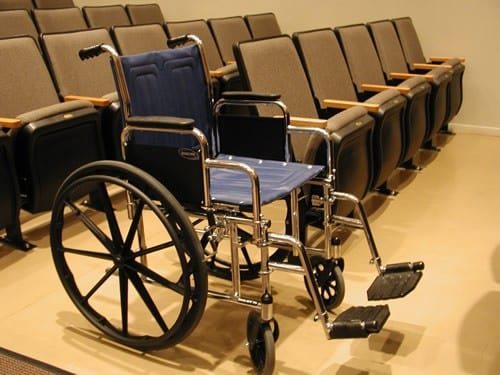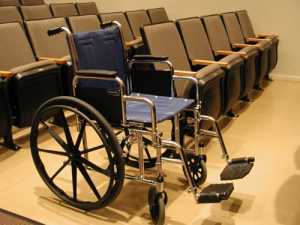
LIMERICK as a city has many facilities for wheelchair users. But able-bodied people regularly abuse them, parking in wheelchair spaces or parking too close to a car with a ‘disabled’ badge to allow the disabled person get in or out. Reporter Bernie English teamed up with full-time carer Tom Clifford to spend a day in a wheelchair and find out what disabled people have to contend with.
THE FIRST thing I realise about being in a wheelchair pushed by someone else is that it’s terrifying.
I could hop out of this chair at any time, the person pushing it is a long-standing friend – Tom Clifford – who has masses of experience dealing with disability, having worked professionally with people with disability and, more recently, as a carer for his wife, who needs a wheelchair after a number of strokes.
He’s someone I trust. Someone who knows what he’s doing.
But still it’s terrifying. Every slope seems too steep. Losing personal control of when it’s safe to move on to the road is completely unnerving and having to travel along the road against on-coming traffic because there are far too few dished footpaths is a nightmare.
The only way for someone pushing to get the chair and its occupant up a step is to tilt the chair right back and the chair user’s instinct – to reach for any possible grip to stabilise the world – has to be revoked for risk of breaking fingers or arms.
I am – quite literally – in someone else’s hands.
We start our day by checking out one of the city’s major tourist attractions, the revamped King John’s Castle and, credit where it is due, it’s very wheelchair friendly. With the exception of the battlements, which have to be accessed by a steep outside staircase, everything else is amenable.
Wherever there are stairs to an exhibit, there are lifts with call buttons at sitting level. One of the situations which my friend and minder, Tom, dreads is gravel because the wheels of the chair stick in it.
But the courtyard at the castle, he tells me, is very manageable as they haven’t spread the gravel too deep. I have a go at manoeuvering the chair myself and it’s very tiring. The choice for a disabled person between pushing the chair themselves and having to rely on someone else is a decision that must be fraught with uncertainty.
The only complaint I can make about the castle is actually something which is out of their control. There are no designated wheelchair spaces in the public parking area for visitors. It’s up to the local authority to designate such spaces.
On the day we visited not many of the parking spaces were in demand but in high tourism season, people are surely queuing up and there is no space between conventional parking slots for someone in a wheelchair to get in and out of a car.
And cobblestones. They’re to be found at various locations around the city and they are very lovely and authentic. But try crossing them in a chair. It’s a bone-rattling, tooth-filling shaking experience.
I need some cash. We can’t find a single ATM that is at the right height for a wheelchair. There may be one somewhere, but we can’t find it. The number-pad is reachable but the screens are too high to see.
So. What am I to do if I’m on my own? Go queue in the bank or divulge my key-code to a passing stranger?
Next stop is O’Connell Street.
The two cars parked in the designated wheelchair spaces both have permit badges in their windows and while at no time did we intend to take up, or ever use, a space designated for people with a disability, we did park just behind.
The spaces are great for a disabled driver who wants to do a bit of shopping in Arthur’s Quay. But being a disabled passenger – as I was trying on for size – is a very different matter.
Streams of traffic barrel towards us as Tom first has to bring the chair around to my side of the car and then get me into it, before pushing the chair back past the traffic lights, against on-coming traffic and around the corner to find a place where the footpath is dipped.
Motorists are making no allowances – in fact one driver blows his horn at us.
There’s no way to get a wheelchair up on the footpath at the point where we parked so we had to face traffic coming around the corner of the shopping centre. And drivers coming at us from over the bridge gave no quarter. It’s downright dangerous and could easily be solved by providing an on-path parking space at the back of the centre, where there’s tons of room and easy access.
Next stop is the HSE offices in Catherine Street.
Well – people in wheelchairs are very likely to have business with the HSE – yes?
We park and are delighted to discover there’s an outside roll-in roll-off lift. Happy days. Until we discover that it’s not attached to the HSE offices, it’s attached to the Sarsfield Credit Union – the HSE are based in the bit of the building around the corner. Down several steps.
Full marks to the Sarsfield Credit Union – the manager tells us they moved to this location at least partly because the last building which they occupied was less than user-friendly, being up an enormous flight of stairs.
“It wasn’t accessible for people using a chair but it was also difficult for parents with babies in buggies,” she explained.
Inside, the credit union has taken the trouble to fit their desks at two levels, one of which can be reached to sign documents from a chair. Hats off to the credit union for inclusion.
Next door at the HSE building, it’s harder to find any such reason to celebrate. There are steps up to the main door and no indication whatever of how people with a disability might access the building.
Staying in character, I have to ask Tom to go inside and inquire of reception. What would I do if I was under my own steam, pushing myself?
It turns out the next gate down from the steps is a wheelchair ramp. This leads to a door which feels a bit like the servants’ entrance to Downton Abbey.
I have a go at getting myself up the ramp, which includes two almost 90 degree turns. Not a hope.
Peddling like fury with my arms, the chair still slides backwards and I have to be caught to avoid a messy encounter with a bush.
Tom takes on the pushing and while we have no apparatus with us to measure the angle of the ramp, in his long experience, he says pushing the chair is hurting his legs, which means the ramp is too steep.
To get into the building we have to rely on an intercom to summon a very courteous staff member and have her bring us through a password-protected doorway.
Apart from the lovely staff, not very encouraging.
And then there’s lunch. So many buildings in Limerick are old and gracious and cannot be retro-fitted but so many more street-level ones could have taken more thought.
We consider numerous places where either of us would normally be delighted to eat but they are off the list because they are inaccessible to anyone in a chair.
People with disability shop for clothes, groceries, gifts and like to dine out like everyone else. Tom tells me most of the people with disability whom he knows would rather chaw their own arms off than negotiate the hazards of the city, including the a-boards on paths, advertising lunch specials and the like, which are another obstacle to be negotiated after finding a parking space and not getting run over getting out of the car.
At the end of the day, I step gratefully out of the borrowed chair – which by the way, is hugely uncomfortable to sit in, if there wasn’t enough else to cope with.
Certainly the situation for people with disability in Limerick is in many ways better than I had expected. But there’s still a way to go.
THE BLUE BADGE
THE day after Limerick Post reporter, Bernie English, travelled the city in a wheelchair, she did a sample survey of parking facilities for disabled people in Limerick city centre.
Of ten spaces checked, eight were occupied by vehicles that were not displaying any permit to park there.
Anyone parking n a designated disabled space is supposed to display the internationally recognised ‘Blue Badge’, which is issued by the Disable Drivers’ Association or the Irish Wheelchair Association.
Those entitled to the badge are people who cannot walk more than 100 feet unaided.
The badge entitles the holder to park for free in any parking space and to park in a disabled space. It does not entitle the holder to park where parking is not usually permitted such as on double yellow lines.
The badge is not free, even to medical car holders, and has to be renewed every two years. It can take up to three to four weeks to be verified and issued to the applicant.
Drivers applying for the badge have to pay €50- €60 for a doctor’s certificate, stating that they are disabled.
There is a fee of €10 for an official photo. A form has to be brought to a Garda station to be stamped by a Garda and there is a fee of €35 for processing the badge itself, bringing the cost for a disabled person to around €100.



